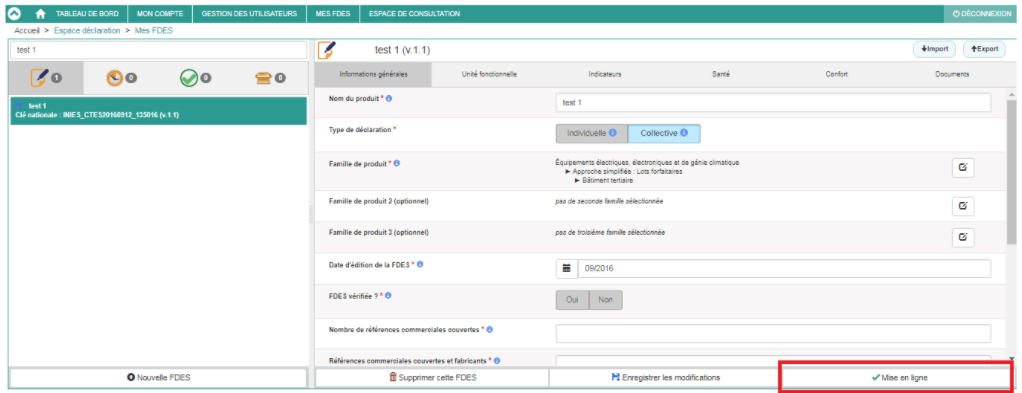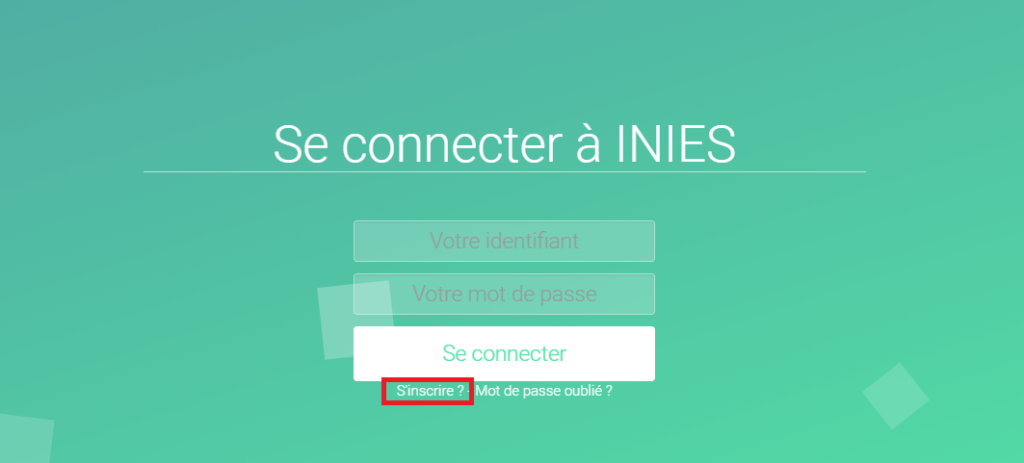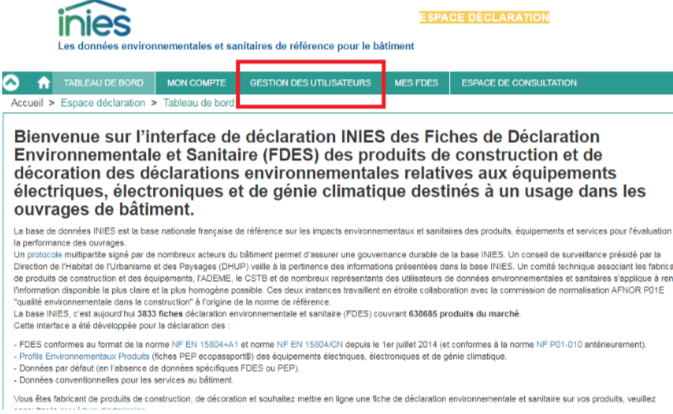How to register an FDES on INIES?
Home » Documentary resources » How to register an FDES on INIES?
Step 1 : Drawing up the FDES (French EHPD / Fiche de Déclaration Environnementale et Sanitaire) according to NF EN15804+A1 and NF EN15804/CN standards
Some good practices in terms of referencing may be recalled to help finding your declarations among the results:
- An FDES can be:
- New or revised
- individual (product manufactured by only one industrial) or collective (product manufactured by several industrials)
- drawn up internally by the declarant or externally
- An FDES must be compliant with the rules of the programme in force
- In case of products with several configurations (different functional units), there must be an FDES for each configuration
Step 2 : Verification of the FDES
- The declarant must chose an accredited INIES verifier
- The declarant provides the verifier with the accompanying report in French (can also provide the verifier with other supporting documents, on request of the latter)
- After examination of the verifier, a verification certificate is issued
Step 3 : Registering the verified FDES on INIES
- The declarant orders tokens via the registration module available in the declaration space, with a view to register his/her FDES. More information on the registration module Here.
- Once payment is made to INIES, the tokens are credited to the organisation’s declaring account. The declarant can then generate his/her registration number(s).
- Affixing the registration number(s) on the FDES and on the verification certificate(s).
- The declarant registers on the INIES Database site: the FDES, the verifier’s report, the certificate issued by the verifier.
Step 4 : Publication of the verified FDES on INIES
- Once the FDES is registered in the declarant’s space, the declarant can then ask for his FDES to be “put online”.

- The validation for putting online an FDES on INIES is carried out in two steps:
- An administrative check managed by AFNOR (payment verification, registration number …),
- And then a technical verification managed by CSTB (verification of the fields entered compared to the FDES in PDF format, relevance of the nomenclature choices…).
- Either to inform him that his FDES is going to the next verification step or is put online on INIES
- Or to inform him that his FDES has been refused at the administrative/technical verification step, with the reason of the refusal. The declarant must then make the necessary updates and resubmit his FDES for verification (via the “put online” button).
Further information
Rates
Registration per unit
| Fees | Price (EUR before tax – VAT 20%) |
|---|---|
|
F1 |
From 1 to 10 declarations: 200 EUR / FDES or LCI From 11 to 50 declarations: 175 EUR / FDES or LCI From 51 to 100 declarations: 150 EUR / FDES or LCI More than de 100 declarations: 125 EUR / FDES or LCIDegressivity conditions of F1 fee: The declarant shall inform the manager of the verification programme of the number of FDES or LCI foreseen per calendar year. All declarations shall be submitted to validation before 31 December of the billing year. No deferral nor refund is foreseen. |
| F2 | 1000 EUR per configurable FDES NB : after that, free of charge for all “daughter” FDES of the configurable FDES registered in the INIES programme |
Flat-rate registration
| Fees | Price (EUR before tax – VAT 20%) |
|---|---|
|
F3 |
3000 EUR per year |
More information about the fees in annex B
Focus on registering and opening the declarant's account
- To apply for admission of an FDES to the manager of the INIES database, the organisation declaring an FDES (union, manufacturer or distributor) must create a “manager” account.
- There can only be one “manager” account per organisation (it is the first account created for the organisation). Subsequently, the “manager” account can create “user” accounts which then can in turn declare FDES.
Note:
The “manager” account can declare FDES and has access to all FDES declared by its “user” accounts. However, “user” accounts only have access to their own declared FDES. It is therefore important to clearly identify within the organisation who is the person in charge of the “manager” account. In the FDES consultation space, the FDES reference contact which will be provided in the field “declaring organisation” is that of the account that has created the FDES.Creation of a “manager” declaration account
Go to the home page → declaration space and click on “register?”
Creation of a “user” account
Once the manager is connected, he can create/delete users for the declaring organisation, via the “user management” tab.
Focus on obtaining FDES registration numbers
Steps for obtaining his/her FDES registration number(s):
- Estimation by the declarant of the number of FDES he will draw up
- Order the required number of registrations at AFNOR (via sending filled in Annex A to the INIES programme)
- Affixing the registration number(s) on the FDES and the verification certificate(s)
Note :
- The numbers bought are only valid for the current calendar year and must be used before 31 December.
- The submitted and validated FDES are valid 5 years.
- The FDES put online on the INIES database and validated can be modified by the declarants: 2 types of modification are possible (see slide 16)
Focus on the coherence robot
When asking to put an FDES online, a window may appear “presumption of anomalies“:
 A coherence robot is automatically launched at each request to put an FDES online.
The purpose of this robot is to highlight inconsistencies in the values entered (for example: the sum of the life cycle phases is different from the column “Total life cycle”), and potential anomalies with regard to the comparative values from the same nomenclature family, which may be due to input errors.
These presumptions of anomalies do not prevent the FDES from being validated and put online. It is possible to look up the results of the robot and modify your digitised data before the request of putting online. It is also possible that the detected potential anomalies are not justified, and therefore to validate the values as initially entered. It is simply a coherence robot which allows to alert in case of big differences with comparative values of the same nomenclature family, but which is not an exact source.
A coherence robot is automatically launched at each request to put an FDES online.
The purpose of this robot is to highlight inconsistencies in the values entered (for example: the sum of the life cycle phases is different from the column “Total life cycle”), and potential anomalies with regard to the comparative values from the same nomenclature family, which may be due to input errors.
These presumptions of anomalies do not prevent the FDES from being validated and put online. It is possible to look up the results of the robot and modify your digitised data before the request of putting online. It is also possible that the detected potential anomalies are not justified, and therefore to validate the values as initially entered. It is simply a coherence robot which allows to alert in case of big differences with comparative values of the same nomenclature family, but which is not an exact source.
 A coherence robot is automatically launched at each request to put an FDES online.
The purpose of this robot is to highlight inconsistencies in the values entered (for example: the sum of the life cycle phases is different from the column “Total life cycle”), and potential anomalies with regard to the comparative values from the same nomenclature family, which may be due to input errors.
These presumptions of anomalies do not prevent the FDES from being validated and put online. It is possible to look up the results of the robot and modify your digitised data before the request of putting online. It is also possible that the detected potential anomalies are not justified, and therefore to validate the values as initially entered. It is simply a coherence robot which allows to alert in case of big differences with comparative values of the same nomenclature family, but which is not an exact source.
A coherence robot is automatically launched at each request to put an FDES online.
The purpose of this robot is to highlight inconsistencies in the values entered (for example: the sum of the life cycle phases is different from the column “Total life cycle”), and potential anomalies with regard to the comparative values from the same nomenclature family, which may be due to input errors.
These presumptions of anomalies do not prevent the FDES from being validated and put online. It is possible to look up the results of the robot and modify your digitised data before the request of putting online. It is also possible that the detected potential anomalies are not justified, and therefore to validate the values as initially entered. It is simply a coherence robot which allows to alert in case of big differences with comparative values of the same nomenclature family, but which is not an exact source.Focus on the modification of an FDES after publication
Types of possible modifications
Minor update
- An update is said to be minor when the definition of the FU and the values of the indicators in the results table are not modified. For example: editorial modifications (typing error, etc.). The product is not modified and the date of validity of the FDES does not change.
- No accredited verifier intervenes. It is therefore the declarant who has the entire responsibility for the modification. However, for the purpose of traceability, the declarant must provide and register in the INIES database the details of the modifications made.
Major update
- An update is said to be major when a verification control point is modified (for example: modification of one or several values of the indicators in the results table). This will therefore lead to a new verification and thus the intervention of a verifier.
- There are 2 cases of major updates:
- Review every 5 years (at the end of the validity period)
- During the validity period, the declarant can choose between continuing his initial period or starting with a new 5 year cycle.
Making a modification
To make a modification of an FDES, the declarant must, in his declaration space, tab “My FDES”, choose among his online FDES, the FDES in question, and click on “Offline for modification”.
 Then, a window asking for the reason of the modification of the FDES will appear.
Then, a window asking for the reason of the modification of the FDES will appear.
 Once taking offline has been confirmed, the FDES to be modified is available in “FDES in process of being set up”.
Once taking offline has been confirmed, the FDES to be modified is available in “FDES in process of being set up”.
 Once the modification are done, you have to click on “Put online” to make the update available online.
Once the modification are done, you have to click on “Put online” to make the update available online.

